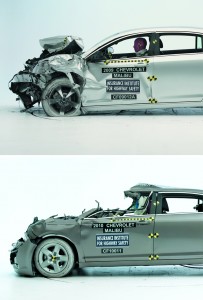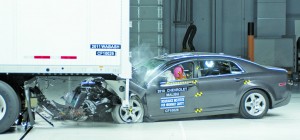
The Institute of Highway Safety tests of a Chevrolet Malibu show a significant difference in crash damage when the car was crashed into another car as compared to a large truck. In the bottom picture, the car was crashed into a Hyundai trailer.
The Insurance Institute for Highway Safety is calling on the federal government to increase standards for semi-truck trailers to prevent passenger cars from sliding underneath in rear-end collisions.
The institute filed a petition with the National Highway Traffic Safety Administration to require better rear guards on truck trailers to reduce deaths in such accidents.
“Cars’ front-end structures are designed to manage a tremendous amount of crash energy in a way that minimizes injuries for their occupants,” institute President Adrian Lund said. “Hitting the back of a large truck is a game changer. You might be riding in a vehicle that earns top marks in frontal crash tests, but if the truck’s underride guard fails — or isn’t there at all — your chances of walking away from even a relatively low-speed crash aren’t good.”
NHTSA estimates that 423 people die each year in passenger vehicles that strike the back of large trucks.
The IIHS tested a Chevrolet Malibu – an IIHS Top Safety Pick – in crashes with trailers from three manufacturers, Wabash, Hyundai and Vanguard. It found that in 35 mph crashes where the car struck a parked trailer squarely, crashes with the Hyundai and Vanguard trailers would likely be fatal, with serious intrusions in the passenger compartment, but the car that crashed into the Wabash trailer did better.

The Malibu fared best when it was crashed into the Wabash trailer, above, as compared to the Hyundai and Vanguard trailers.
The key is the underride guards on the trailers. The Wabash trailer was certified to the more stringent Canadian regulation for underride guards.
“It’s clear to our engineers that Wabash understands how underride guards and trailers work together as a unit instead of treating them as separate components,” Lund says. “Strong attachments kept the Wabash guard in place so it could engage the Malibu, allowing the car’s structure to absorb and manage the crash energy. In the real world, this would be a survivable crash.”
After the Wabash’s good performance in the full-width test, engineers had high hopes for the offset tests where the car struck the trailer on the corner. The outcome for the Wabash was different when the overlap was reduced to 30 percent. The struck end of the guard again bent forward, and this time there was severe underride.
This test shows that even the strongest guard left as much as half of the rear of the trailer vulnerable to severe underride. The guard only worked as intended when the striking car engaged the center.
“Under current certification standards, the trailer, underride guard, bolts, and welding don’t have to be tested as a whole system,” Lund points out. “That’s a big part of the problem. Some manufacturers do test guards on the trailer. We think all guards should be evaluated this way. At the least, all rear guards should be as strong as the best one we tested.”
Another problem is that regulatory gaps allow many heavy trucks to forgo guards altogether. When they are present on exempt trucks, guards don’t have to meet 1996 rules for strength or energy absorption.
“Underride standards haven’t kept pace with improvements in passenger vehicle crashworthiness,” Lund said. “Absent regulation, there’s little incentive for manufacturers to improve underride countermeasures, so we hope NHTSA will move quickly on our petition.”
Predecessors of the NHTSA have had underride guard regulations since 1953, but they’ve never been required to be tested as a complete system. IIHS hopes to change that with its petition.
